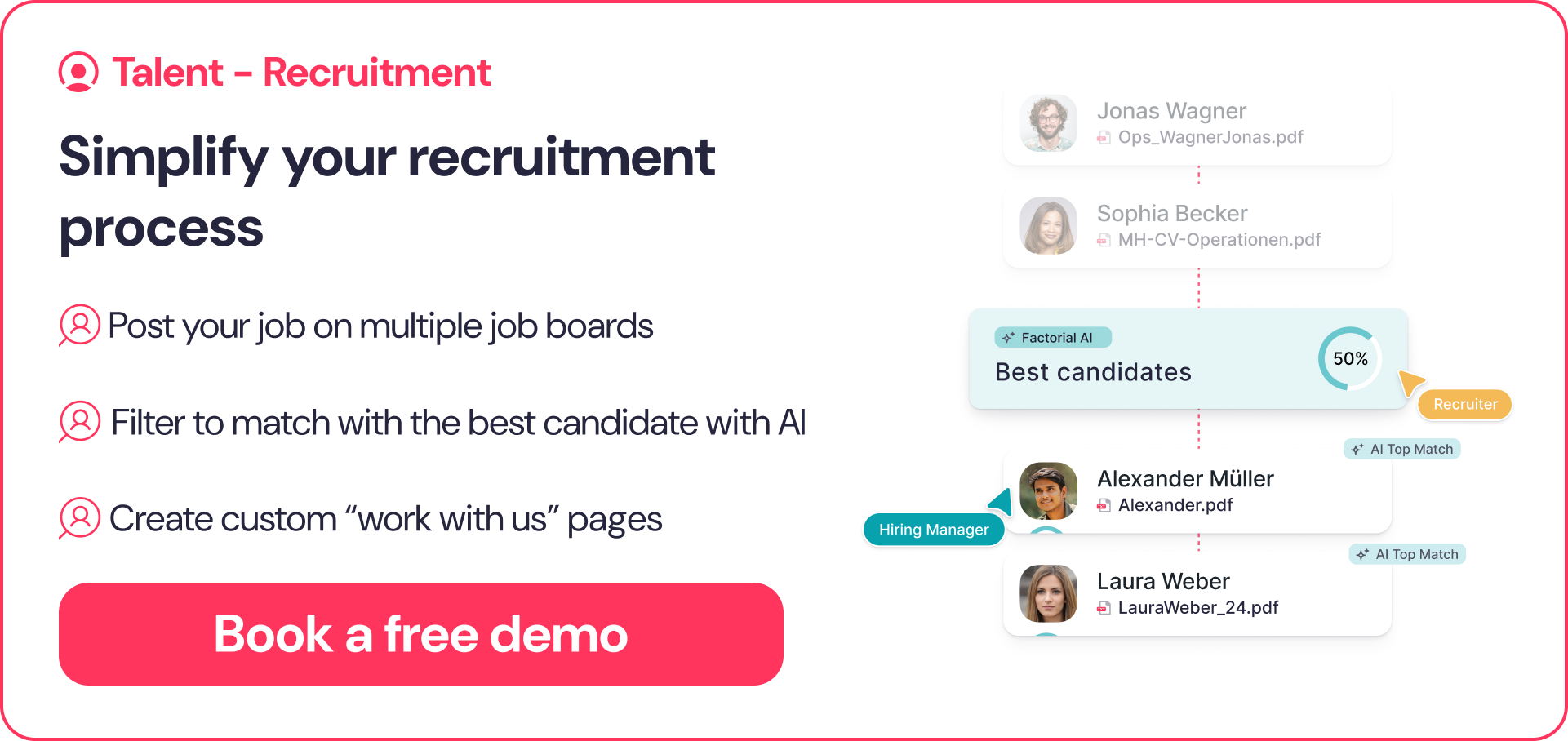The world is changing rapidly. Technology is revolutionizing the workplace and changing the workforce. More and more companies are not producing tangible products but digital ones. This means that now, more than ever, a business’s success is determined by its problem-solving abilities, knowledge management, and human capital development. But what is human capital?
Human capital is the economic value an employee provides through their skills, knowledge, and abilities. In some industries, this expenditure may make up as much as 70% of a company’s operating costs.
This buzzword is on the tip of everyone’s tongue. Here, we’ll dive deeper into what this capital is, how it can be measured, and what it can do for your business.
- What is Human Capital?
- Human Capital Management
- Human Capital Risk
- The Core Aspects of HCM
- Harnessing Technology
- Humanizing Business
✅ Utilize Factorial’s management software for small business to lead your team
Definition: What is Human Capital Management?
The human capital meaning may seem complicated, but it is actually a simple idea. It supposes that investments in people (e.g., education, training, health) will increase an individual’s productivity. A more productive employee will be more valuable to an employer.
Now, as far as the actual human capital management definition, you can sum it up as the set of practices that human resources managers should follow when hiring, managing staff, and optimizing the workforce.
The need for and implementation of a human capital management system began some time ago. Let’s take a look at how this came to be:
-
A Brief History of Human Capital Management
The concept of human capital can be traced all the way back to Adam Smith, father of capitalism. Capital is that which allows a business to generate revenue. Smith famously outlined four types of capital:
-
- Useful machines
- Buildings
- Improvements to the land
- The acquired and useful abilities of all the inhabitants or members of a society
The idea further gained traction in the 1960s when economists Gregory Becker and Theodore Schultz reported that the rise in U.S. per capita income was correlated with an increase in schooling. In short, employees with higher levels of education were worth more to employers.
Since then, researchers have gone on to inquire what other investments pay off in productivity gains.
-
What Creates Human Capital?
According to the theory of human capital, human capital trends tend to follow economic growth. In wealthier countries, more workers have access to the education they need to be productive workers.
Every year, the World Bank publishes an annual Index Map to illustrate how access to education and health resources affects the productivity and prosperity of nations around the world.
Once basic criteria of education and healthcare are met, workers can develop more specific skills or abilities which may make them even more valuable. For example, they may pursue a graduate or undergraduate degree. A 2018 Federal Reserve study found that those with a college degree are paid 74% more than those with only a high school degree. Employees may also acquire skills through training and development programs in the workplace, experience, or connections.
There are three types of human capital:
-
- Cultural Capital: These are the soft skills which enhance an employee’s ability to work in a demanding field. Interpersonal skills help employees to communicate with clients and colleagues.
- Social Capital: This refers to the relationships a person has built over time.
- Intellectual Capital: This is the knowledge, achieved through education, higher education, experience, or training. This understanding enables the employee to produce high-value labor.
This kind of capital is an intangible asset, but it remains absolutely necessary to the success of both an individual worker and a business. It is especially important for businesses that rely on knowledge capital.
What is Human Capital Management (HCM)?
Businesses must see employees not as a cost but as an investment. Forward-looking companies are fostering the strategic capabilities of the HR department by retooling it to practice human capital management.
Creating a human capital department, businesses can better manage their greatest resource. We will delve into exactly what is human capital management and how it affects you and your business.
Human Capital Risk
There are many problems that may arise from a poorly managed workforce. These problems are referred to as human capital risk. When there is a gap between the goals of an organization and the skills of the workforce, risks can take five forms:
- Dissatisfaction: When workers are unhappy with work conditions.
- Attrition: When a company faces high turnover, leading to hiring and lost productivity costs.
- Corruption: When employees misuse their position for illicit personal gain.
- Catastrophe: When accidents or disasters injure workers, damage property, or hurt a business’s reputation.
- Negligent Hiring: When companies hire or retain employees who are not qualified for their work.
Human capital management solutions will help HR departments to mitigate these risks. By relying on data analytics and strategic planning, HR teams can take a more proactive role. They can determine what problems may arise and how they can be addressed.
The Core Aspects of a Human Capital Management System
Human capital management is an opportunity to understand workers not as costs, but as assets. To address risks, human capital hr departments can take a four-pronged approach.
Planning
First, businesses must determine their workforce needs. What risks are most relevant to the business? If employees are dissatisfied, why? How can employers make sure the workforce is large enough to complete the necessary tasks while also ensuring employee mobility?
Talent Acquisition
The first phase of an employee’s life cycle is the acquisition, which is to say hiring. With rigorous practices for recruitment, applicant tracking, onboarding, an HCM approach will tap top talent for open positions.
Managers will need to screen for:
- Competence: That the employee has the appropriate skills and knowledge to fill the role and complete their duties.
- Compliance: That the employee complies with federal and state regulations regarding non-discrimination and inclusion.
- Diversity: Employers also want to make sure their workforce reflects a commitment to reflect diverse communities.
Employee Management
Next, HCM must maintain its workforce. To keep employees satisfied, businesses should strive to have seamless administrative functions, such as employee annual leave management and automated payroll for wages and salaries.
Managers should also ensure employees receive education and training to perform their roles. Performance management is a key part of human capital management solutions. By systematizing goal-setting and task-tracking, an HCM approach paves the path to success.
It also provides the necessary oversight to prevent corruption, and communication to improve retention and reduce what causes high turnover rate.
Talent Optimization
Proactive businesses are always seeking to improve employee engagement, up productivity, and get the most from their workers. Human capital strategy dictates that workers don’t just train their workers for the skills they need right now, but also for the skill set they will need in the future. This might involve re-skilling or up-skilling. This creates a flexible workforce so that employees can pursue opportunities for growth and development.
Harnessing Technology: Using Human Capital Management Software?
In today’s knowledge economy, investments in human capital are more important than ever. Businesses must invest in human capital hr solutions or risk falling behind.
Technology plays a vital role in this changing landscape, especially a human resources management software for businesses. Moreover, human capital management software can help employers to address potential problems before they occur.
From the start of the employee life cycle, applicant tracking will help to streamline and organize the hiring process. Automated time-tracking and absence scheduling can help to reduce confusion and limit employee dissatisfaction. Performance management tools will keep employees on track to realize their potential.
The successful human capital strategist will create an organization with a positive country culture designed to adapt to disruption.
Humanizing Business: What are Human Capital Resources
Although this kind of capital is an intangible asset, businesses must remember that it is as vital to their success as the goods and services they provide. Well-managed employees will lead not only to improved productivity, but to improved attitude, and increased employee satisfaction. When they invest more in their workers, companies are bound to see a return on investment which endures.
If you’ve ever asked yourself, “What is human capital?” now you know that it is one of the most important questions you can ask in today’s changing landscape.
Effectively Manage Your Human Capital with Factorial – Try it for free [Free 14-day trial].
Written by Valerie Slaughter; Edited by Tanya Lesiuk


